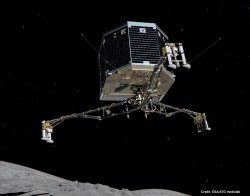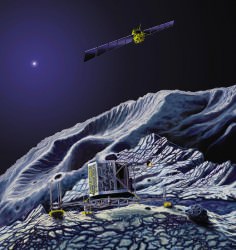Why is landing on a comet so difficult and what does this tell us about future missions to comets and asteroids?
Us nerds were riveted by the coverage of the ESA’s Rosetta mission and its arrival at Comet 67/P in 2014. One such nerd is Paco Juarez, friend of the show and patron. He wanted to know why is it so darned hard to land on a comet?
In 2014, the tiny Philae Lander detached from the spacecraft and slowly descended down to the surface of the comet. If everything went well, it would have gracefully touched down and then sent back a pile of information about this filthy roving snowball.
As you know, the landing didn’t go according to plan. Instead of gently touching down on 67/P, Philae bounced off the surface of the comet like a tennis ball dropped from a tower, and rose a kilometer off the surface. Then more descending, and more bouncing, finally settling down on rugged terrain, surrounded by crevices and large boulders. At that point, engineers lost contact with the lander, and so much science went undone.
If I recorded this video a few months ago, that would have been the end of the story. You know how this goes, space exploration is hard and dangerous, don’t be surprised when your missions fail and space unfeelingly smashes up your pretty little robot probes with their little gold foil 27 pieces of flair.

Fortunately, I’m able to report that ESA regained contact with the Philae lander on June 13, 2015, resuming its mission, and scientific operations.
But why is landing on a comet so difficult and what does this tell us about future robotic and human missions to smaller comets and asteroids? When ESA engineers designed Philae, they knew it was going to be very difficult to land on a comet like 67/P because they have a such a low gravity. And they have low gravity because they’re little.

On Earth, 6 septillion tonnes of rock and metal give you an escape velocity of 11.2 km/s. That’s how fast you need to be able to jump in order to leave the planet entirely. But the escape velocity of 67/P is only 1 m/s. You could trip off the comet and never return. Whilst small children threw rocks at you from the surface as you drifted away.
Philae was built with harpoon drills in its landing struts. The moment the lander touched the surface of the comet, those harpoons were supposed to fire, securing the lander. The surface of the comet was softer than scientists had anticipated, and the harpoons didn’t fire. Or possibly they were broken and couldn’t fire. Space is hard. Whatever the case, without being able to grab onto the surface, it used the comet as a bouncy castle.
We’re learning what it takes to land on lower mass objects like comets and asteroids. NASA’s OSIRIS-REx mission will visit Comet Bennu, and send a lander down to the surface of the asteroid. From there it’ll pick up a few samples, and return them back to Earth. It’ll be Philae, all over again.

In the future, we’re told, humans will be visiting asteroids to study them for science and their potential for ice and minerals. You can imagine it’ll be a harrowing descent, but even just walking around on the surface will be dangerous when every step could throw an astronaut into an escape trajectory. They’ll need to learn lessons from rock climbers and Rorschach.
As we learned with Philae, landings on low mass objects is really tough. We’re going to need to get more practice and develop new techniques and technologies before we’re ready to add asteroid mining to our list of “stuff we just do, NBD”.
What are some unusual worlds you’d like humanity to visit? Put your suggestions in the comments below.


Instead of developing the super cables for the space elevator, the focus should be on developing a lasso system for unevenly shaped objects such as Comet 67P/Churyumov-Gerasimenko.
Lasso? Maybe you mean something like this which NASA’s NIAC program recently financed for a one man one year investigation, hitchhiking with a passing comet. UT bloggers should write more about NIAC, it is a gold mine of spectacular futuristic ideas, some of which make even Fraser look like a realist 😉
https://www.nasa.gov/content/comet-hitchhiker-harvesting-kinetic-energy-from-small-bodies-to-enable-fast-and-low-cost/#.Vc26QPmqpBc
In the SETI talk below an ESA guy explains that they’ve figured out that the harpoons never fired because they wired them wrong. But that they now know how to fire them (I think there are two) if the contact gets stable enough. They have science value too and would measure surface hardness and underground temperature:
http://www.seti.org/weeky-lecture/rosetta-lander-philae-mission-landing-comet-67pchuryumov-gerasimenko
In the SETI talk below an ESA guy explains that they’ve figured out that the harpoons never fired because they wired them wrong. But that they now know how to fire them (I think there are two) if the contact gets stable enough. They have science value too and would measure surface hardness and underground temperature:
http://www.seti.org/weeky-lecture/rosetta-lander-philae-mission-landing-comet-67pchuryumov-gerasimenko
In the SETI talk below an ESA guy explains that they’ve figured out that the harpoons never fired because they wired them wrong. But that they now know how to fire them (I think there are two) if the contact gets stable enough. They have science value too and would measure surface hardness and underground temperature:
http://www.seti.org/weeky-lecture/rosetta-lander-philae-mission-landing-comet-67pchuryumov-gerasimenko
Hi FarAwayLongAgo,
to your reply “Lasso? Maybe you mean something like this which NASA’s NIAC program recently financed for a one man one year investigation, hitchhiking with a passing comet. UT bloggers should write more about NIAC, it is a gold mine of spectacular futuristic ideas, some of which make even Fraser look like a realist 😉 https://www.nasa.gov/content/comet-hitchhiker-harvesting-kinetic-energy-from-small-bodies-to-enable-fast-and-low-cost/#.Vc26QPmqpBc
I think the space elevator cable is a “bridge to far” as a first step.
The first development of a super cable should not be something the diameter of my pinkey finger and 32000 miles long, rather the diameter of a thread you would use to sew a button on a coat, and only a few hundred miles long.
I am not a big fan of the harpoon idea because of the unknowns of the target composition.
Firing rockets or harpoons into the surface for deep soil testing is a good idea, but only after the probe has landed, although for really accurate analysis, drilling to obtain a core is still the best solution.
I think the basic space elevator concept has no future. There’s no material to make it work at massive planets like Earth where it is needed. And on tiny objects like Phobos where it could be built today, there’s no need for it since one can jump into orbit from there. Besides, it is a “Line up and wait for your turn at the only launch site” kind of system. Everyone loves waiting for the elevator, right? A conventional launcher today has much more flexibility.
But there are variations with freely swinging cables that could catch stuff. More difficult to evaluate. Maybe some of that would be really good. This blogger has written about it and about much more in an accessible and very well illustrated way.
http://hopsblog-hop.blogspot.se/
Most recently “Pogo hoppers on the Moon”, he beat Fraser to it! But there is reason in the madness.
Thanks for linking to my blog! However I disagree on the utility of a Phobos elevator. The purpose of a Phobos elevator wouldn’t be to get off Phobos’ surface. But rather to fling stuff out of Mars orbit or drop stuff to Mars surface. See http://hopsblog-hop.blogspot.com/2015/06/phobos-panama-canal-of-inner-solar.html